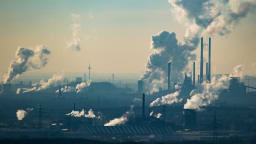Climate-related warfare is a near-term reality—not some far-off boogeyman—according to leading defense thinkers and military strategists. They are still talking about the importance of fighting climate change, but they’re also making plans to fight other human beings because of climate change.
So, where will these climate-related battles take place?
Some people argue they already have, with controversial academic reports claiming recent conflicts were directly spurred by the effects of climate change. Other military advisers and strategists have identified specific new wars that could erupt in Asia, Africa, or the Arctic.
The Atlantic Council, an American think tank, suggested in March that as Russia and China look to new shipping routes through previously frozen, impassable waters around Greenland, Iceland and the Arctic Circle, there could be a new era of great power competition in the region.
Britain and the U.S. have responded to a huge increase in Russian and Chinese activity in the area with a beefed up military and naval presence. An American aircraft carrier recently ventured into the Arctic Circle for the first time since the end of the Cold War.
Matthew Rendall, a lecturer at the University of Nottingham whose research focuses on climate change and international relations, argues that it is more likely that less stable, more disaster-prone places like Syria or Somalia will become the climate battlefields. “They are already hot. Most of them are also a lot poorer. As a result, they’re more likely to suffer acute resource shortages, mass migration of refugees, and political instability.”
“Moreover,” Rendall said, “China and Russia have nuclear weapons. They may quarrel over the Arctic, but they are unlikely to fight World War III over it—that would just be too costly.”
According to a recent article published by the political risk analysis firm Global Risk Insights, there may already be reasons to think violence in Somalia is linked to climate change. Millions of Somali people have begun to face food insecurity after “almost continuous dry spells since the 2011 East Africa drought.” While studies of past conflicts have not conclusively linked these effects to the increased presence of the jihadist group al-Shabaab, the article argues that “jihadists benefit from climate-induced livelihood loss and food insecurity,” and as the climate worsens, they can use offers of things like food and protection to recruit the vulnerable. ”
The Pentagon is making nearly identical observations as Global Risk Insights, without directly naming the potential combatants. “As climate changes,” according to the U.S. Department of Defense’s plan which was first published in September and then publicized earlier this month, “there may be commensurate alterations in local and regional politics to mitigate food and water shortages. These political adjustments could result in increased physical and cyber terrorist attacks from unknown third parties.”
The Pentagon’s new “Climate Adaptation Plan” is illustrated with a photo of two awestruck soldiers standing in California’s Mojave desert, silhouetted against a giant, all-consuming sun on the horizon. The image undeniably evoked the mushroom clouds U.S. military photographers captured in the Southwestern desert three-quarters of a century ago. The sun’s useful—but increasingly oppressive—energy is now at the forefront of the Pentagon’s thinking just as atomic energy animated the American militarism of a bygone era.
In 2015, a research team led by Colin P. Kelley, a researcher at Columbia University, produced a well-publicized study concluding that the now decade-long civil war in Syria was worsened by climate change-related heatwaves and drought and the subsequent fights over resources, which stirred up the unrest put down so brutally by President Bashar al-Assad.
“
It is going to be a very grave disaster.
”
Olaf Corry, University of Leeds professor of global security challenges, told The Daily Beast that while climate change will certainly have a “huge” impact on security, the conflict in Syria is a bad example, because he sees major weaknesses in the research linking that conflict to climate issues. Among other factors, he said, “The droughts were in the wrong place to correlate with the places the unrest broke out that were the trigger for the Assad crackdown.”
“We don’t want to let those responsible for starting wars erroneously point to ‘climate’ and thereby get off the hook,” Corry explained.
It may be that we should focus less on conflicts over resources, and more on what happens when there’s simply less land due to rising sea levels. Shafqat Munir, head of the Bangladesh Center for Terrorism Research reminded the attendees of the Seoul Defense Dialogue last month that his country is expected to rapidly lose about 14 percent of its total landmass. From a terrorism researcher’s standpoint, he said, “As you can imagine ladies and gentlemen, it is going to be a very grave disaster.”
For instance, the Rangpur district of Bangladesh has been transformed by recent floods, experiencing its worst flooding in 60 years last year. That same district has also experienced an apparent rise in conflict between Hindus and Muslims. Over the past few weeks in the Rangpur district, Islamist groups have reportedly committed arson attacks against dozens of Hindus during the Durga Puja Hindu festival. A clear link between climate and this violence hasn’t been established, but the changing climate is on the minds of ordinary citizens in Bangladesh according to Munir. “From my perch in Dhaka, Bangladesh, climate change is not a theory because we live it every moment,” he told the Seoul Defense Dialogue.
It was the first time the Seoul Defense Dialogue, an international meeting of military minds from Southeast Asian countries, South Korea, and some of their Western allies, had ever dedicated an entire panel to the topic of climate.
If we fail to lower emissions very soon, “militaries should be planning for profound insecurity and more military missions later in this century, or possibly sooner if we hit certain tipping points,” said Sharon Burke, president of the defense research firm Ecospherics, and a former assistant secretary of defense under President Obama.
Overwhelmingly, the focus of the conversations at the Seoul Defense Dialogue was not where these new conflicts would take place, but rather, strategies for engaging in warfare under hotter, stormier, less predictable conditions. Bangladeshi peacekeeping forces in Mali, where Bangladesh has been operating since 2014, have encountered increasingly inhospitable temperatures. But more to the point, according to Munir, they’ve had communications equipment fail due to the heat.
“The shift I see happening among [U.S.] defense policymakers,” said Jeff Colgan, a professor of political science at Brown University, and director of the Climate Solutions Lab, “is that they are starting to see climate change not just as a ‘threat multiplier’ (the Pentagon’s favorite phrase) or as a single issue, but as altering the whole strategic landscape that the United States faces.”
As John Kerry, special presidential envoy for climate, tweeted shortly after the election of Joe Biden, “America will soon have a government that treats the climate crisis as the urgent national security threat it is.”
Corry, the University of Leeds professor, said Kerry’s tweet was an example of climate “securitization”—which he defined as “making something understood through the lens of security.” Corry questioned this approach, asking “Why is it ‘national security’ and not ‘human security’ or an ‘ecological security’ crisis?”
The military strategies being generated to confront these new issues focus on adapting to the new challenges, not massively reducing their own carbon footprints. The Pentagon’s climate change plan does talk about reducing greenhouse gas emissions, but “mitigation” is third on the plan’s list of guiding terms, after “adaptation” and “resilience.”
The Department of Defense consumes up to 80 percent of the U.S. federal government’s energy, according to a 2019 report by The Watson Institute for International and Public Affairs at Brown University. That same report also notes that the U.S. military’s 2017 greenhouse gas emissions—about 59 million metric tons—exceed those of the entire country of Sweden.
“If the rich countries—the chief causers of global warming—start pouring money into their national security apparatus instead of decarbonization and helping vulnerable countries adapt, it will add insult to injury,” Corry said.
Perhaps it’s time U.S. military leaders, in particular, spent less time planning for new climate-related warfare and more time figuring out how they can stop making it more likely.

